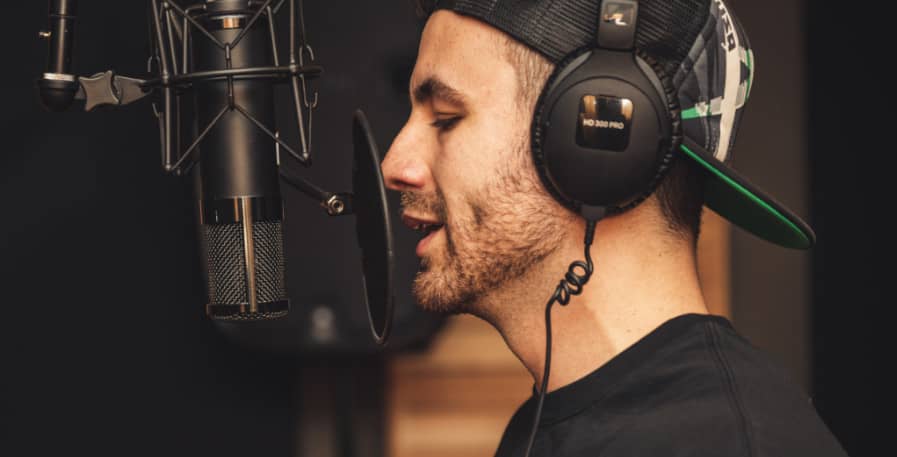Previously, I have pointed out why singing and playing bass is hard. This time around, I`m going more in-depth about how to make it easier to play bass and sing and the same time.
Among other things, I`ll cover what to focus on when practicing. In addition to the vocals and the bass playing, I`ll also show you the importance of posture, breath, and method.
You will learn how to choose the right songs to practice, and why it makes a big difference. There will also be some tips on how to prepare for learning a song on two instruments at once. Lastly, I`m going to show you some tips for how to analyze your practice, and what to do when you feel stuck.
1. Choose The Right Songs
There are countless bass lines that will take years of practice to play while singing. In general, this is not because they are overly technical. It is because the bass rhythm is vastly different from the vocal line.
When starting out, I advise against practicing syncopated bass lines. These are lines that emphasize the backbeat and are typically rhythmically different from the vocals.
Instead, choose songs with fairly straightforward bass lines. Lines that consist of straight 8th notes, lots of whole notes, or rhythms that match up well with the vocal line are all great.
If nothing of this sort comes to mind, I have made a list of easy songs to sing while playing bass. These are all beginner-friendly for various reasons and make for a great place to start.
This is important, as even beginner to intermediate bass lines can feel incredibly overwhelming when singing at the same time. Thus, you will save yourself a lot of needed hardship by choosing easy songs. This also mitigates the chance of you giving up on singing and playing bass altogether.

2. Learn the bass part first
Through the years, I`ve tried learning songs in all kinds of ways.
When it comes to singing while playing bass, I`ve found it significantly easier to learn the bass part first.
Not only that, but it is best to learn the bass part as thoroughly as you can. What I mean by this, is that you want to know the entire line by heart. This includes being able to play it without much effort, and ideally without looking at your bass.
This gives you more room to focus on your singing, while the bass serves a more fundamental role. Learning the vocal part first does not lead to this type of foundation. As a result, it will be harder to connect the two parts together if you attempt it.
Therefore, my best tip is to completely neglect the vocals at first. Only start singing after the bass part has become second nature. While this can feel ineffective at first, I can tell you from experience that this will lead to you ultimately learning both parts faster.
3. Relax & Breath
Playing the bass and singing requires focus and control. A lot of this comes down to practice. However, there are some external aspects of your playing that also makes a huge difference.
Namely, what worked well for me was to focus on my posture, breathing, and tension. This led to better control of my singing and bass playing and prevented stagnation in my progress. Years later, I also realize that this was helpful for mitigating pain and injuries.
For the best posture, stand upright. Make sure you are using a strap height you are comfortable with. The bass should rest naturally against your body. Also, avoid slouching over the bass. Slouching makes the bass more cumbersome to play, and negatively affects the quality of your singing.
Relax your shoulders. If you are like me, you might naturally start to raise them when you concentrate. This leads to more tension, which in turn makes playing harder. I used to raise my shoulders without even noticing, so it helps to be mindful of whether you have a tendency to do this too.
Lastly, a controlled breath is important when playing the bass. This is because not controlling it can lead to back pains due to the tension improper breathing can cause.
It is even more important when singing. The reason for this is that improper breathing can lead to worse projection and resonance. Especially so if you feel too stressed to take proper breaths from the diaphragm.
While all these points will require some practice, they are all great ways to see some quick improvement in your technique. They are also points that it is helpful to revisit as you improve as both a vocalist and bass player.

4. Use A Mirror
As for how to improve at the abovementioned points, I recommend practicing in front of a mirror.
I mentioned this tip in my article on playing bass without looking at your hands. Thus, it applies equally well to singing, as the goal is to become comfortable enough to not look at the fretboard.
When playing in front of the mirror, look out for whether you are doing any of the following:
- Raising your shoulders – Pay extra attention to this when playing parts that you find particularly difficult
- Slouching over the bass – Watch out for whether you start doing this as a practice session starts to drag out
- Looking down at the bass – This is acceptable when practicing, but should be done less and less as you become comfortable with a song
- Awkward Fretting – Are you fretting notes where you think you are fretting them? If not, I recommend working on this going forward, as it will be harder to sing while playing harder songs later on.
- Forgetting to breathe – Are you taking rushed breaths before you sing a line? Or, are you forgetting to breathe between the lines? This can be hard to notice when concentrating but can be easier to detect in the mirror.
While looking at yourself this way can feel a bit weird at first, I can tell you from experience that it is also immensely helpful. This goes both for vocalists and bassists and is exponentially important when both singing and playing.
5. Decrase the Tempo
One of the best ways of achieving a clean bass tone and playing with control is to play a song slowly at first. The same holds true when learning to sing at the same time.
With that said, singing a part slower can feel a bit more awkward than playing it slower on the bass. Thus, be prepared for the fact that this can take some time to get used to.
Once you get over the initial hurdle though, playing a song at a slower tempo will greatly improve your control of it. Then, as you become comfortable playing and signing it slowly, you can gradually increase the tempo.
You will eventually be able to play the song at its original tempo by using this method. When you do, you will be able to play it with a level of control and comfort you otherwise would not have.
Not only that, but in my experience, this has enabled me to learn songs faster. This is because it is a whole lot better to gradually improve your control than not see any progress when a song feels too overwhelming at full speed.
In general, I like to start at 60 BPM and move up to 5 BPM at a time once I get comfortable. This is a great starting point, but if a song calls for it, it is perfectly fine to start at faster or slower tempos. Especially so if the vocal line becomes so dragged out that it becomes physically difficult to sing.

6. Record Yourself
Similar to watching yourself in the mirror, recording yourself is helpful for noticing strengths and weaknesses in both your singing and bass playing.
As previously mentioned, there is a lot that goes into doing both at the same time. Thus, it is easy to overlook how you actually sound. This is especially true for the vocals, as we sound vastly different on recordings than we think.
When listening to recordings of yourself, pay extra attention to the following:
- Control – Were you in control of both the vocal and bass part? If you did slip up, was this during a particularly difficult part of the song?
- Pitch – Noticing whether you are singing on pitch is generally easier when listening back. Pay extra attention to this during vocal parts with fast phrases.
- Rhythm – Are you playing on time, or are you at times rushing or slowing down? If you are, I`ve found it helpful to work on staying relaxed, with better rhythm control following as a result.
- Bass Line VS Vocals – If there are mistakes, are you making these in your singing, bass playing, or both? By identifying this, you will have a better idea of which of these areas to work on. If you are struggling with both, I recommend practicing the bass line til it becomes second nature first.
This is all helpful for noticing weaknesses and strengths. It is also helpful for identifying what parts of a song you struggle with and what parts you are starting to master.
7. Practice the Rhythms first
By the end of the day, playing bass and singing at the same time is all about matching up two different rhythms.
Therefore, it can be a great way to focus on the interplay between these two rhythms before anything else.
What has worked well for me, is to clap the bass part on my right thigh, and clap the vocal line on my left thigh.
This feels like a drumming exercise but has been immensely helpful in preparing me for learning songs. The exercise makes you learn both rhythms, and notice how they play off one another.
The best thing about this is that it makes it easier to notice where the vocal line and bass part deviate. This will show you what to expect from the song in terms of difficulty.
By identifying these parts, you will know what parts are most likely to be challenging. Not only that, but you will also be more well-equipped to master them. This is because you will develop a feel for how the rhythms differ and work together.
This exercise can be helpful prior to learning a song. Alternatively, it is also a great way to gain new mastery of it if you feel stuck in your practice.

